How to Design Beaded Flowers: Five Easy Rules
In case you don’t already know me, I have been de signing and making French beaded flowers for 15 years. I have recently published my second book on the subject, so I thought it was time I shared a few tips on how to design beaded flowers.
signing and making French beaded flowers for 15 years. I have recently published my second book on the subject, so I thought it was time I shared a few tips on how to design beaded flowers.
I know there are those of you who like to simply follow patterns and those who like to create your own. If you are someone who likes to follow a pattern, then I am sure you will find it fascinating to realise what goes into this behind the scenes. If not, you can at least get a special deal on my two French beaded flower books by following this link here. If you want to know how to design beaded flowers for yourself, then just read on.
Two Schools of Thought
When it comes to designing French beaded flowers, I see two schools of thought. The ‘realists’ who like to create designs that are botanically accurate, and the ‘artistic license’ who enjoy creating pretty flowers.
That may sound like a denigration of the talent, or you may be thinking that these designers create fantasy flowers. I do not wish to suggest either. There are obvious advantages to the realist approach: if you are actively trying to replicate something from nature, then arguably, you should try to do this with accuracy.
However, I want to argue that it is not always as straightforward as this. If you consider beadwork, in any form, to be art, then what is the purpose of art? Having looked at both sides, I am going to give you five simple rules about how to design beaded flowers.
Realism
For anyone who is wary of designing because they feel they have no ideas, or they fear that their ideas are ‘not good enough’, a realist approach may seem very helpful. It saves having to come up with the idea: all you need to do is find an object and work out how to re-create it using beads.
Benefits of the Realist approach
So, you immediately cut out some design decisions. Colo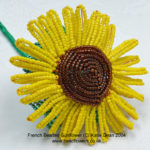 ur is already given since you will be copying the colouring from the real thing. You are really just left trying to decide on which beads and which techniques will work best. Or are you?
ur is already given since you will be copying the colouring from the real thing. You are really just left trying to decide on which beads and which techniques will work best. Or are you?
Potential Problems with the Realist approach
To my mind, the biggest issue with copying a real object is scale. Botanically, most flowers have certain common components: petals, sepals, stamen, buds, leaves and more. The distinction between flowers comes from the different sizes and shapes of these components. If you are trying to replicate a flower with absolute botanical  accuracy, then ideally you want to study an actual flower. You want to count the petals, you will need to examine the stamen in detail – how are they shaped, coloured, how many are there?
accuracy, then ideally you want to study an actual flower. You want to count the petals, you will need to examine the stamen in detail – how are they shaped, coloured, how many are there?
This is all a brilliant idea, but what if your flower has 100 stamen? Are you going to really make that number from beads? If you do, what is this going to do to the size? Typically, the real stamen will be very tiny and very delicate, so even if you were able to use tiny size 18 beads, it is entirely possible that your 100 stamen will still be bigger than the actual flower you were copying. Once you have set the size of the stamen you need to make everything else to scale. Are you then in danger of having to create petals that are 6” across when in reality, the flower’s petals are just 1”?
If you have ever tried any French beading, you will also have realised that the combination of thousands of beads and the wire makes these flowers very heavy, so trying to create a ‘giant’ flower may even be a practical impossibility.
How to design beaded flowers using the realist approach
Where does this leave you in terms of realism? I believe some compromises are necessary. It may be prudent to reduce the actual number of stamen and focus on trying to make them look as similar to the real thing as possible, but trying to keep to a realistic overall size.
What about petals? Is it acceptable to change the number of petals, or does this make your flower unrecognisable? The answer to this depends on the flower. If it is something with, say, five petals, there is a strong argument for keeping to that number. If it is a flower like a rose, the actual flower may have many petals, but if you try to create the same number in beads, you will end up with an unworkable design. Again, the problem lies in the fact that nature’s material is extremely thin and pliable, in comparison with a beaded version. It would be lovely in principle to replicate nature exactly, but in practise, you need a balance between accuracy and practicality, I think.
Let me leave you with that food for thought while I talk about artistic license. I will then bring you the simple design rules that have worked for me.
Artistic License
So, when does artistic license go too far? There really is no concrete answer to that question. It is a matter of opinion.
I came across this question on a personal level when a French beaded poppy pattern t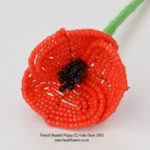 hat I had designed came in for some heavy criticism because it only had three petals instead of the botanically accurate six. In point of fact, there are many varieties of poppy, not all of them look the same, so possibly the flower that had inspired my design may not have been the same variety that my critic had in mind. Naturally, I defended my design choices, rightly or wrongly. My biggest argument was, and still would be, that I am free to interpret as I wish. The flower that I created was instantly labelled by others as a poppy, whether botanically accurate or not. On this basis, I hold it to be a viable design.
hat I had designed came in for some heavy criticism because it only had three petals instead of the botanically accurate six. In point of fact, there are many varieties of poppy, not all of them look the same, so possibly the flower that had inspired my design may not have been the same variety that my critic had in mind. Naturally, I defended my design choices, rightly or wrongly. My biggest argument was, and still would be, that I am free to interpret as I wish. The flower that I created was instantly labelled by others as a poppy, whether botanically accurate or not. On this basis, I hold it to be a viable design.
If you take this argument out into the world of art, it is a debate that has raged and evolved over centuries. Is the work of an artist like Rembrandt, where a portrait of a person looks so real that you feel you could touch the skin and it would feel soft and warm, superior to an impressionist painting where you need to add a little of your own imagination? The answer is, both require different skills from the artist, so how can you judge which is superior? Both also evoke different reactions from the viewers and any reaction is fine. I see art as a way to communicate with and through our emotions and imaginations, so there is no right and wrong.
How to Design Beaded Flowers
Where does this leave you if you are thinking of designing? The really big message is that last one: there is no right and wrong. As a designer, you are free to express your imagination. The caveat is that you also have to accept that some people will like this and some will not.
In practical terms, if you want to know how to design beaded flowers (or something else), I have some useful rules to follow.
My First Rule of Beading Design
Firstly, if you want the object to be recognisable, you need to replicate it with some level of accuracy. However, m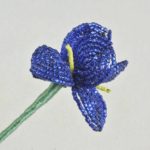 uch will depend on the complexity of your object. In some ways, think of this as like drawing a cartoon. You are aiming for a simplified version of the real thing, but it must be complex enough to be recognisable.
uch will depend on the complexity of your object. In some ways, think of this as like drawing a cartoon. You are aiming for a simplified version of the real thing, but it must be complex enough to be recognisable.
My top tip for this rule is clipart! I often look at how clipart portrays real-life objects. It can help to see this simplified version as you think about how to design beaded flowers, or other objects.
My Second Rule of Beading Design
Secondly, you will need to think about scale. I would like to suggest that there is a simple rule to help with this. Begin with the smallest part of your o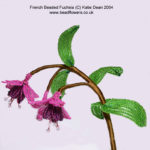 bject, then scale everything else to fit. If you start by making the largest part, you may find that the scale you need for the smaller areas is just too small to be achievable with beads.
bject, then scale everything else to fit. If you start by making the largest part, you may find that the scale you need for the smaller areas is just too small to be achievable with beads.
For this rule, taking the flowers as an example, start with the tiniest part – the stamen in the centre. Continue to build the centre first, then you can design the petals to a suitable size. This will give you a flower that should be to scale.
My Third Rule of Beading Design
Thirdly, think about colour: the same rules apply here. If your actual object is made from straightforward, bold colours, you should have no problem. If the actual object contains detailed patterns or subtle shading, you will want to find some way to adapt and simplify those so that they are workable.
My top tip here is to use the bead colouring to your adv antage. (You can find some helpful blogs about colour theory here, if you need it). Try things like creating a bead mix if you need your flowers to look mottled. Remember, you want to use beads that are similar in colour in order to get a realistic effect.
antage. (You can find some helpful blogs about colour theory here, if you need it). Try things like creating a bead mix if you need your flowers to look mottled. Remember, you want to use beads that are similar in colour in order to get a realistic effect.
Alternatively, if you are thinking about something like an orchid with spotted petals, then try balancing the mix. For example, maybe try 90% main colour beads with 10% spotted beads in a bead spinner. The spinner will add the beads randomly, so you may end up with colour patches or even spots, but this should look quite realistic.
Lastly, you can bead different rows using different colours of beads. This may be more fiddly to do. You may in fact need to thread the beads by hand for this, but the effort will pay off.
My Fourth Rule of Beading Design
Whether you are contemplating how to design beaded flowers or not, my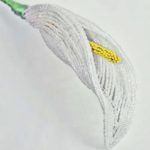 fourth rule is really important to remember. Practice makes perfect! You may not get it right first time around. Almost certainly, you will need to experiment with different ideas. You may even be tempted to see the attempts that don’t meet your expectations as failures. They are not. These are possibly the most important part of design.
fourth rule is really important to remember. Practice makes perfect! You may not get it right first time around. Almost certainly, you will need to experiment with different ideas. You may even be tempted to see the attempts that don’t meet your expectations as failures. They are not. These are possibly the most important part of design.
Every time you try an experiment, you will learn something new. With every new lesson, you will get closer to hitting upon the effect you are seeking to achieve.
My Fifth Rule of Beading Design
You cannot design anything unless you are familiar with all the techniques. Whether we are talking about how to design beaded flowers or how to design in general, beading techniques are the basis of everything.
The 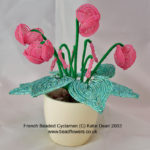 more techniques you learn, the more variety you will have at your fingertips. So, if you are worrying about how to get started, just start at the beginning. As you learn a new technique, you will automatically be thinking about how to apply it. So, perhaps you will find some designs even emerge from techniques.
more techniques you learn, the more variety you will have at your fingertips. So, if you are worrying about how to get started, just start at the beginning. As you learn a new technique, you will automatically be thinking about how to apply it. So, perhaps you will find some designs even emerge from techniques.
Taking you back to the realist example where I started, if you have learned the different loops techniques, the different basic techniques, you have tools. These tools mean that when you look at a flower, you will immediately see whether the petals look like loops. Or, perhaps they look more circular – in which case you know to turn to the basic technique. Either way, this gives you the starting point that you need.
Where to go from here
I promised you a simple guide to how to design beaded flowers. So, I have given you some ideas to consider, some rules to follow. Now you need a path to take.
I said that before you start to think about how to design bead flowers or anything else, you need to master techniques. So, let me start there. My ebook, uded video demonstrations for each one, so you can learn at your own pace.
My second book, Bead Flowers and Corsages shows you more techniques! I structured this so that you could progress and learn how to create more complex shapes. Again, all the techniques are shown with great video demonstrations. You might almost imagine I’m in your beading room with you!
Having said that you need as many techniques as possible at your disposal before you start working out how to design beaded flowers of your own, I have just put together a special bundle. If you buy both books at once, you can save yourself some money.
So, please follow the links above to order your ebooks.
Facing your fears
What if the task of learning how to design beaded flowers now seems a bit daunting? Well, don’t give up. Even if you have yet to pluck up the courage to make your first design, you can still learn the techniques. Then go on to try making some of the many flowers I have created. Build your courage slowly and one day inspiration will strike.
You can always follow the blogs on here to get more helpful design hints while you build your confidence! So, happy beading and don’t forget my five rules…










